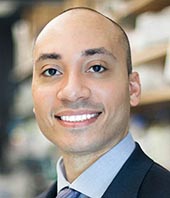Scott, Wang to investigate new approach to subunit vaccination
"We usually try to be very clean and precise in medicine and in engineering, but nature usually works under very dirty conditions. In the case of vaccination, the combination of these different components can be critical to the generation of an effective and long-lasting immune response."
Evan Scott, SQI faculty member
Simpson Querrey Institute faculty member Evan Scott recently received a four-year, $2.9 million grant from the National Institute of Allergy and Infectious Diseases to develop a multi-subunit vaccine for tuberculosis, one of the top 10 causes of death worldwide. Scott and co-principal investigator Chyung-Ru Wang will use a unique polymeric nanoparticle formulation in the first attempt to combine both lipid and protein molecules within one subunit vaccine, which could boost the effectiveness and longevity of the therapy.
Some of the most effective and long-lasting vaccines that are presently administered are known as attenuated vaccines. They contain live pathogens — such as bacteria or viruses — and evoke a substantial immune response. But they are expensive and time-consuming to develop, require specific storage conditions and their production can be highly variable across the globe.
These limitations have sparked interest in engineering subunit vaccines, which contain a portion of the pathogen, usually a protein or peptide, along with a polymer, oil or emulsion to facilitate delivery. These synthetic creations are lower cost, easier to reproduce and customize, and can be scaled quickly.
But they still have a major obstacle to overcome.
“Subunit vaccines never achieve the long-lasting broad immune responses that you get with an attenuated vaccine, and one reason for that is that a lot of the key components of the pathogen are missing,” said Scott, an associate professor of biomedical engineering at Northwestern University.
Scott and Wang, a professor of microbiology-immunology at Northwestern, have long believed that adding the lipid component to the formula could trigger a broader immune response by activating lipid-specific T cells. But this approach has gone largely uninvestigated due to the lack of a suitable small animal model.
Wang's lab has solved that problem by developing unique mouse models which express lipid-presenting receptors that are normally missing in mice. Humans have five receptors that present lipids, while mice typically have just one.
Wang's humanized mouse models and Scott’s nanoparticle delivery systems will enable the researchers to test the immune response elicited by a multi-subunit, bioengineered vaccine that activates both lipid- and peptide-specific T cells. Scott and Wang believe that both of the molecular components are crucial to mimic the natural biology of the pathogen.
“We usually try to be very clean and precise in medicine and in engineering, but nature usually works under very dirty conditions — where many different components are all mixed in together,” Scott said. “In the case of vaccination, the combination of these different components can be critical to the generation of an effective and long-lasting immune response.”
If the investigators’ approach is successful, multi-subunit vaccines could be developed for a range of conditions and rival the effectiveness of attenuated vaccines — without the high cost, limited storage options and variability.

